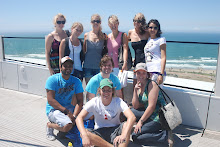Tuesday 9 March 2010 marked our first collective visit to the Moses Mabhida stadium. Some had visited the stadium in their individual capacity, but now it was time for the ten of us to experience it together. The initial intention was to do an educational tour through the stadium from 11am till noon. On arrival however, we were told that we didn’t qualify for the educational (free) tour, as we were not a school. We were a little confused by this given that we are university students completing an Honours degree. I really don’t know how much more educational one could get? We decided to boycott the tour of R75, and instead purchased tickets for the Sky Car.
Before embarking on the Sky Car trip the lecturer, Naretha, and I decided to make a quick trip to the “Public” toilet facilities in the stadium. I write “public” as the first sign that one is confronted with reads: “No Contractor’s Workers Allowed to Use This Facility.” So this means that the Contractor’s may use the bathrooms, but no person putting in all the work, time and effort may use the bathrooms. There is no indication of the alternate location for the ‘workers’ to use, but a few of us concurred that they were probably, and in all likelihood, substandard porta-potties*.
(* Individual toilet facilities that can be transported from place to place. Frequently found at field-hosted events such as concerts etc. They usually smell terrible, are poorly ventilated and have limited to no water supply.)
What was noted was that it is surprising, given our complicated past of segregation and discrimination, that we are still able to enforce segregated use of facilities, especially when they are deemed public. One questions why the people working for the contractors are any less deserving to use to toilet facilities, and what prejudices are held against these workers that make their use of the toilets ‘undesirable.’
In turn, it makes one question how Fifa and the stadium will begin to determine and restrict the notions of ‘public space.’ The by-laws already begin to speak of restrictions and the undesirables. There are areas referred to as Exclusion Zones, these are areas that are controlled and demarcated by the municipality, they exist around the outskirts of the stadium’s perimeter. These exclusion zones and controlled access zones create a sense of division.
Part of the reasoning behind going to stadium was to allow us to begin to question these restrictions and the space in general. In pairs we will be creating activations and interventions in different spaces around the city and stadium. Hopefully we will be able to document these through photographs, videos and written material for others to engage with.
- Kate
Saturday, March 13, 2010
Subscribe to:
Post Comments (Atom)


Can somebody's dissertation this year explain the possible uses of the glorious stadium after the World Cup? I think Evita Bezuidenhout suggested that the residents at Cato Manor could move in - then uncle mike can use the 'Sky Car' as a real tourist attraction. Or better yet, build a bridge (similar to the Warwick one) over the newly formed village (imagine the shopping center you could fit under there).
ReplyDelete